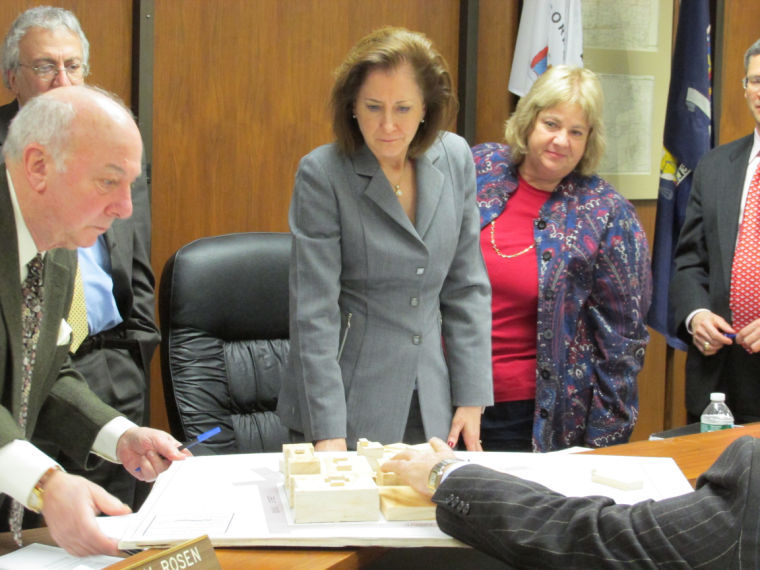The possible future of Grace Avenue was on display at Great Neck Plaza’s Village hall Wednesday, Feb. 6, as the village board examined two proposals for buildings containing both commercial space and apartments.
Developer Hooshang Nematzadeh’s presented his plan to build a four-story retail-residential facility at 5-9 Grace Avenue in the proposal’s first formal hearing, after four previous appearances before the board.
Attorney Paul Bloom, representing Namdar Realty Group, showed the board plans to revamp 3 Grace Avenue, which is adjacent to the building Nematzadeh proposes to develop. The proposal by Namdar Realty would add 2.5 stories and turn the 3 Grace Ave. building into a 29-unit apartment building with first-floor commercial and professional space.
Bloom said his client intended to have construction coincide with work on Nematzadeh’s project, and that the building would contain high-end apartments marketed to younger professionals and commuters priced out of the Manhattan real estate market.
“We’re trying to attract those younger people,” Bloom said.
Bloom said the developers would try to minimize disruption, citing a 15-18 month timetable for construction and measures taken to avoid displacing current residents.
“We are told by our architects it is possible to build around our current tenants in the building,” Bloom said.
Board members were skeptical about several aspects of the Namdar Realty proposal, which is in its preliminary stages and has not yet been submitted in a formal application.
Village of Great Neck Plaza Trustee Pamela Marksheid questioned how construction would be staged, given the lack of on-site parking for trucks and other vehicles.
Bloom responded that he hoped to coordinate construction with Nematzadeh’s project, but that he had not held formal talks with Nematzadeh on the subject.
Trustee Gerald Schneiderman was not put at ease by Bloom’s explanation.
“Having the construction of two of these [buildings[ would create such havoc in the downtown,” Schneiderman said. “I would be a little nervous.”
Schneiderman also questioned how the building could support the parking needs of its tenants, and board members were skeptical of Bloom’s suggestion that residents could obtain permits for municipal lots.
Trustees also took issue with the design of the building, which Village of Great Neck Plaza Mayor Jean Celender described as “boxy.”
“I think we have a bunch of design issues to get past,” Celender said. “At least I have.”
“This to me, I’m looking at a bunch of boxes that could be a prison,” Schneiderman said.
Bloom stressed that the project was in its beginning stages and that the board’s criticism would be relayed to the architects.
Nematzadeh’s project, which had been subject to revisions and design changes after its four previous appearances before the board, was met with greater enthusiasm.
Nematzadeh, a developer, Kings Point trustee and head of the Great Neck Chamber of Commerce, said the project’s location offered a unique development opportunity.
“You can hardly find downtown a lot of this size,” he said.
The building, which after board concerns over density was reduced to 37 units, will still require three zoning variances, Nematzadeh said.
The plan calls for a five-foot setback from the street instead of the 25-foot setback required by village zoning. Nematzadeh said the variance is necessary for the viability of the building’s retail space. The 42 -foot height planned for the building exceeds the 40-foot maximum set out in village code, and Nematzadeh also requested a variance to allow both commercial and residential units on the building’s first floor.
Board members said the revised plan had taken into account earlier criticism from village trustees, including complaints about design aesthetics.
“I think that this is really much improved and will be an asset to the area,” said Schneiderman.
The board said it would hold another hearing on the project at its next meeting.
Both projects take advantage of the Plaza’s 2011 zoning reform, which allows mixed commercial-residential buildings in the downtown near the Long Island Rail Road station.
The change was designed to provide housing options for commuters who might be discouraged by the area’s high real-estate prices.
The median price for a home in Great Neck is $877,500 in 2010, according to Newsday.



